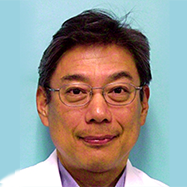Division of Gastroenterology and Hepatology

Director Takefumi Nakamura, MD, PhD
Kansai Electric Power Medical Research Institute
①Liver Disease
(1)Non-alcoholic fatty liver disease: NAFLD; non-invasive evaluation using a new technique, FibroscanⓇ
FibroscanⓇ is a new instrument, compound of ultrasonic elastography and fat deposition measuring system. Using this non-invasive technique, we can evaluate
fibrotic change and steatotic change in the liver, quantitatively and repeatedly. First, we assess the validity of FibroscanⓇ in the diagnosis of NAFLD, comparing with histological finding.
Second, assessing FibroscanⓇ and blood test data, we evaluate the characteristics of patients with severe liver disease progression among patients with various disease, such as diabetes mellitus and fatty liver.
Third, we prospectively evaluate the risk factors for NASH in patients with NAFLD using the various parameters and data obtained with FibroscanⓇ.
(2)Treatment of Liver cirrhosis: interventional research
Carnitine is a small molecule amino acid derivative. It is essential physical component in energy metabolism, transport of fatty acid to mitochondria, regulation of metabolism by co-enzyme-A, and stability maintenance of red blood cell membrane.
Carnitine is mainly synthesized in the liver. In patients with chronic liver diseases, especially in patients with liver cirrhosis, the synthesis of Carnitine is insufficient but disturbed.
Regarding the clinical use, Carnitine is reported as effective in patients with viral liver cirrhosis in small number of literature. It activates mitochondrial function
and improves symptoms such as convulsive attack and hypotonia. We evaluate the effectiveness of Carnitine in patients with non-viral cirrhosis such as steatohepatitic and alcoholic cirrhosis.
②Neuroendocrine tumor
Genomic analysis of pancreatic NEC and MANEC; Collaboration with the Department of Surgery, Kansai Electric Power Medical Research Institute, and Department of Gastroenterology and Hepatology, Kyoto University School of Medicine
Neuroendocrine carcinoma is defined as Grade-3 Neuroendocrine Tumor. To obtain new information about the pathogenesis and genomic background, we analyze pathological samples of NEC using genome wide association study: GWAS.
Selected Recent Publications
| Writer | Publications |
| Yamaga Y, Tsugihashi Y, Nakamura T, Taniguchi T, Honjou G, and Kage M | Sunusoidal obstruction syndrome with hypereosinophilia successfully treated with predonisolone. Clin J Gatstroenterol 5:24-30, 2012 |
| Okano A, Takakuwa H, Nakamura T, Ohana M, Kusumi F, and Nabeshima M | Rectosigmoid Xanthoma as a Predictive Marker for Sporadic Rectosigmoid Cancer. J Clin Gasteoenterol 45(9):837, 2011 |
| Okano A, Takakuwa H, and Nakamura T | Spontaneous regression of diffuse intrahepatic recurrence with portal vein tumor thrombus after resection of hepatocellular carcinoma. Clin J Gatroenterol 4:43-48, 2011 |
| Oda Y, Kou T, Watanabe M, Sakuma Y, Taguchi N, Kako Y, Yamauchi A, Sugiura Y, Ohashi S, Asada M, Fukunaga T, Kawaguchi K, Ito H, Nakamura T, and Yazumi S | Regression of B-cell Lymphoma of the Liver with Hepatitis C Virus Infection After Treatment with Pegylated Interferon-a and Ribavirin. Dig Dis Sci 55:1791-1793, 2010 |
Members
| Director | Takefumi Nakamura, MD, PhD |
|---|---|
| Deputy Director | |
| Researcher | |
| Visiting Scholar |